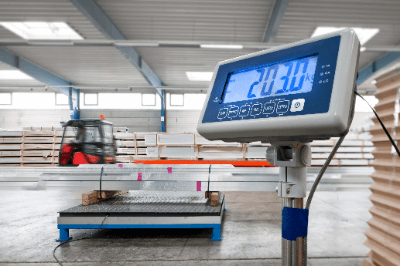What Is an Industrial Scale?

Industrial scales are measuring instruments used to weigh things in the production and development of products, whether in agriculture, forestry, fisheries, or industry.
There are various types of industrial scales, ranging from electronic balances used for precise weighing in laboratories, such as chemical analysis, to floor scales that are embedded in the floor and used to weigh large trucks. Furthermore, there are various types depending on the intended use and measurement environment, such as:
- Dust-proof specifications for weighing powders.
- Waterproof specifications for weighing light liquids.
- Explosion-proof specifications for weighing in hazardous locations such as where explosive gases are generated.
Industrial Scale Applications
Industrial scales are used in a variety of industries to determine weights. Specifically, they are used in laboratory laboratories in the chemical field for research and development and analysis, in the agriculture, forestry, and fishery industries, in production plants for industrial products, and in warehouses in the logistics industry.
In the production and logistics industry, they are used to determine the quantity of products. For example, to count the number of small screws, the weight of about 100 pieces can be stored in advance on an industrial scale, and the number of products can be determined simply by placing them on the scale.
Industrial scales are also incorporated in a series of automated manufacturing processes, such as the automatic filling of liquids and powders, filling volume inspection, weighing for batch processing, blending, and dispensing. Industrial scales are used in a variety of fields, including the pharmaceutical, cosmetic, chemical, and food industries.
Principle of Industrial Scales
General scales include spring scales based on Hooke’s law and balances based on the principle of leverage, but industrial scales mainly use electromagnetic, load cell, and tuning fork measuring principles.
1. Electromagnetic Industrial Scales
The internal structure of an electromagnetic industrial scale is similar to that of a balance. A sample is placed on one side of the rod, and an electromagnetic coil is placed on the opposite side of the rod across the fulcrum.
The electromagnetic force required to maintain equilibrium for the weight of the sample is measured, and the electromagnetic force is converted to weight. The electromagnetic method enables measurement with high accuracy and is suitable for analytical balances and other scales that measure minute samples.
2. Load Cell Type Industrial Scale
This type of industrial scale is composed of a strain gauge that detects the distortion of the load cell and a body that is distorted by the weight of the body. One side of the body is fixed, and a sample is placed on the other side.
The strain generated by the weight of the sample is extracted by the strain gauge as a resistance value and converted to weight. The structure is relatively simple and inexpensive. This method is suitable for measuring heavy objects when high precision isn’t required.
3. Tuning Fork Industrial Scale
Tuning fork industrial scales measure the frequency of oscillation of a sample when a load is applied to a transducer consisting of two connected tuning forks, and convert the frequency to weight. This is a relatively new measuring principle, and its measurement accuracy is somewhere between that of the electromagnetic and load cell types.
Other Information on Industrial Scales
1. Platform Scale
Platform scale is the general term for a scale that measures the weight of a stationary object by placing it on a platform. The platform is designed to sink due to the weight of the object placed on it, and the extent to which it sinks is measured as the weight of the object.
There are a variety of products for a wide range of purposes and capacities. Examples include household scales, kitchen scales, store scales, scales for measuring the volume of propane gas, and truck scales, which have a structure with a weighing platform on the floor and can carry a large vehicle by itself.
In addition to the spring-loaded analog type, there are also a wide variety of products with various uses, weighing capacity, and price ranges. Examples include scales with load cells, electromagnetic sensors, digital types with digital numeric displays, and waterproof and explosion-proof builds.
2. Weighing Table
This is the name of the weighing pan or platform on which the object to be measured is placed in a weighing instrument. Depending on the manufacturer, it is sometimes called a weighing platform as a product name for a platform weigher.
3. Electronic Balance
An electronic balance is mainly for measuring mass. Some models have a built-in balance structure, while others have a one-block structure without a balance structure. The measurement methods of electronic balances include the electromagnetic force balancing method, load cell method, and tuning fork vibration method.
The electromagnetic force-balancing method was the most common type of electronic balance in the early days, but the strain gauge load cell type is now widely available. In general, the measurement accuracy of the electromagnetic force balancing method is higher than that of the load cell method.